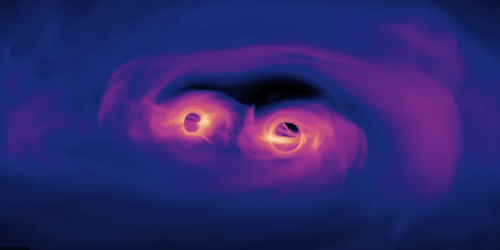Dark Matter Could Bring Black Holes Together
A gravitational-wave “hum” pervades the Universe. Researchers believe the hum originates from the mergers of supermassive black holes (see Research News: Researchers Capture Gravitational-Wave Background with Pulsar “Antennae”), but models have been unable to fully describe the merger process. Now Gonzalo Alonso-Álvarez of the University of Toronto and his colleagues have proposed that mergers are facilitated by interactions between two black holes and a certain kind of dark matter [1].
For two supermassive black holes to spiral together and merge, they must lose a significant fraction of their orbital momentum. When the black holes are far apart, this momentum loss can happen via gravitational interactions with passing stars. When they are close, it happens by the generation of gravitational waves.
Researchers have proposed that, in the intermediate regime, when the black holes are about 0.3–3 light-years apart, the system could lose momentum through gravitational interactions with dark matter. This momentum-loss mechanism works so long as the black holes orbit within a high-density region of dark matter. But Alonso-Álvarez and his colleagues note that, under most dark-matter models, momentum gained by the dark matter causes the density to quickly decrease soon after this mechanism becomes active.
Alonso-Álvarez and colleagues show that this problem disappears if the dark-matter particles can scatter off one another. In their model, this scattering slows the momentum-induced dispersal of the dark-matter particles enough for the gravitational attraction among the particles to maintain the density necessary for the inspiral to continue. Previously, models incorporating such self-interacting dark matter have correctly predicted the shapes of dark-matter halos observed by astronomers.
–Marric Stephens
Marric Stephens is a Corresponding Editor for Physics Magazine based in Bristol, UK.
References
- G. Alonso-Álvarez et al., “Self-interacting dark matter solves the final parsec problem of supermassive black hole mergers,” Phys. Rev. Lett. 133, 021401 (2024).




